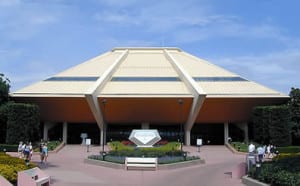On October 1, 1983 EPCOT Center celebrated the 1st anniversary of it’s opening. It also brought along with the celebration one of the most beloved rides ever associated with Disney. A ride that a lot of people hold dear to their hearts then and now, and is also one of the most missed rides that has come and gone. I am talking ,of course, about Horizons. Horizons was the only attraction in Future World to showcase all of EPCOT’s Future World elements (communication, interaction, energy, transportation, anatomy, physiology) into one attraction and was located between World of Motion and the Universe of Energy. The Wonders of Life Pavilion became it’s neighbor in 1989.
My first experience with the ride was in July of 1983 when I was 6 years old. As a little boy looking at the building, I couldn’t help thinking how much it looked like a spaceship. Was this ride about extra-terrestrials, or about life forms different than our own? I must admit that I was intrigued. As we rode the ride, I was a little taken aback by what the ride was about. It wasn’t about E.T (which was one of my favorite movies then), but it was about what the future might look like. I remember smelling the oranges as we rode through the grove scene (an effect later used in Soarin”). I remember the theme song “New Horizons” like it was yesterday. It has been 15 long years since I last rode the ride, but since then websites have come along to where I can ride it once more.
So please sit back, relax and join me as we travel back to a time when EPCOT was called EPCOT Center, when Dreamfinder accompanied Figment, and Ellen and Bill Nye didn’t hang out with dinosaurs, because “Horizons 1 is now departing. Our final destination today: the 21st century.”
The History of Horizons
Those of you who are familiar with Tomorrowland know Walt Disney’s Carousel of Progress is an attraction that follows an American family through the 20th century as they live through the advent of electricity and other advances in technology. Horizons was proposed to be a sequel of sorts. It was to pick up with the same family a generation later with the parents now being grandparents, communicating with their children who are spread out all over the world and on into space, showing how they may live in the 21st century. Carousel’s theme song “There’s a Great Big Beautiful Tomorrow” was even part of the Looking Back at Tomorrow portion of Horizons. But the first concept was a little different than what we eventually got.
There were several working names for the pavilion early on. There was Century III and FutureProbe. Ned Landon, the GE rep on the Horizons Imagineering team said that FutureProbe wasn’t bad, but thought that it had a rather uncomfortable medical connotation. Ned was always comfortable with Horizons though, he said “There always is a horizon out there. If you try hard enough, you can get to where it is and when you do, you find there’s still another horizon to challenge you, and another beyond that.”
Although records show that the “idea germination” was in 1980, there was a first attempt at a concept in 1979 by George McGinnis, who was the project show designer for Horizons and Colin Campbell, who was another Disney Imagineer. General Electric was the pavilion sponsor, who also sponsored The Carousel of Progress at the time. They presented GE chairman, Reginald Jones and Jack Welch (future CEO of GE) with the concept of the ride through focusing on Thomas Edison and his work along with the origins of GE. But Jones did not like the idea of having another history show, which Carousel pretty much was. He suggested to tell the story of GE’s current technologies.
Marc Nowadnick presented Jack Welch with a post show concept called “FutureFair.” It was going to be a “hands on” post show area that would have showcased GE’s range of businesses that as a conglomerate owned. But when the idea was presented Welch saw it as being too commercial, so the idea was omitted. After opening day, exit polls were showing that guests really enjoyed Horizons, but were having trouble making the connection between Horizons and GE that FutureFair would have provided. So one solution was to add GE’s logo throughout the ride on set pieces and place a lighted corridor leading to a large static electricity light bulb displaying GE’s logo.
The Omnimover
The attraction used the Omnimover conveyance system that was used in such rides as Haunted Mansion, Journey into Imagination, and Spaceship Earth. But the Horizons Omnimover system is a little more notable. Why you may ask? It was the only attraction to use an inverted conveyance system. The ride vehicles did not rotate. They traveled sideways throughout the whole attraction to effectively place the viewer into the scene. The first full-size ride vehicle mockup built for testing was done by Gil Keppler and George McGinnis in just 13 hours.
The OmniSphere
The OmniSphere was a massive theatre that the ride vehicle rode past. Before the building design could be completed, the theatre had to be in position. The Omni-Max theatre was beneath the center of the pyramidal form of the pavilion. It was made up of two 8 stories tall and 8 stories wide Omni Max screens. It was originally intended to be the big ending experience, but was used to tell the “Present” with all the amazing advances in science and technology. McGinnis originally designed the theatre to hold three screens, but had to cut one out due to budget restraints.
Check back next week for Part 2
- Disney Throwback – Do You Remember Body Wars at Epcot? - February 17, 2024
- 15 Fun Facts About Rock ‘n’ Roller Coaster Starring Aerosmith - February 11, 2024
- Disney History ~ Discovery Island - February 8, 2024





